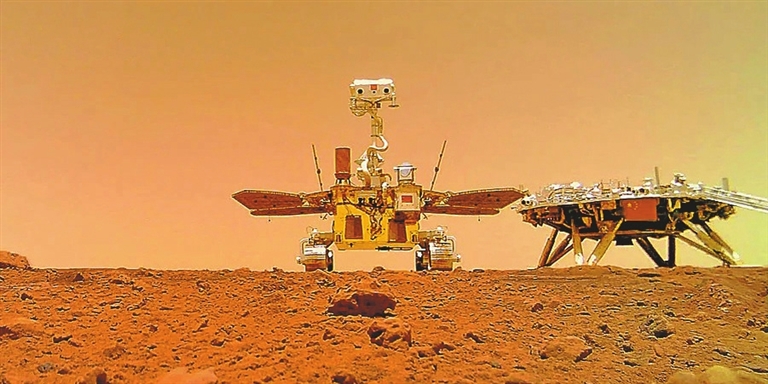
LAUNCHING in 2028, China’s Tianwen-3 Mars sample return mission could bring Red Planet rocks back to Earth as early as 2031 — years ahead of competing U.S.-European efforts. On May 14, 2021, China’s Tianwen-1 lander plummeted from space to streak through the skies above Mars’ vast plain of Utopia Planitia, with an aeroshell protecting it from the heat and plasma of its high-speed atmospheric entry. After unfurling its parachutes and pulsing its engines to zero in on an amenable landing site, the spacecraft touched down safely onto the Red Planet, where it deployed a rover, Zhurong, to explore the surrounding alien landscape. This engineering feat was hugely significant, confirming China as a major player in planetary exploration. With Tianwen-1’s touchdown, China became the only other nation ever to successfully land on Mars besides the U.S. Moreover, the mission also paved the way for a far more ambitious and unprecedented project. That project, Tianwen-3, is set to launch via two Long March 5 rockets from Wenchang spaceport on Hainan Province in late 2028. One launch will carry Tianwen-3’s lander, while the other will transport the mission’s Mars orbiter, which is also an Earth-return vehicle. The mission aims to collect samples of Martian rock and soil for delivery back to Earth, where subsequent studies could, potentially, redefine our understanding of life itself and our place in the cosmos. A sample-return mission “Tianwen-3 will be the first mission aiming to bring back material from another planet to search for signs of life,” says Li Yiliang, a professor of astrobiology at the University of Hong Kong and one of the authors of a paper published in Nature Astronomy on June 19 that offers new details on the mission. Tianwen-3 will use the same approach as Tianwen-1 to make planetfall in a yet-to-be-selected landing area. The vagaries of spacecraft engineering, however, demand the site should be somewhere in the midlatitudes of the planet’s northern hemisphere; it also must be at an altitude of at least three kilometers below the planet’s average elevation so that more of Mars’ thin air can serve to slow Tianwen-3’s descent. The lander will use proven tech from China’s lunar explorations, drilling as deep as two meters for subsurface samples and scooping up material from the surface. Additionally, a helicopter drone — following the lead of NASA’s pioneering Ingenuity flights — will collect selected additional rock and loose particle samples from within around 100 meters of Tianwen-3’s landing site. The lander will operate for around two months on the surface, in which it will use scientific payloads such as a ground penetrating radar and a Raman spectrometer to gather more data on the broader geological context for collected samples. When the time comes, it will fire off a solid rocket booster to send a canister containing at least 500 grams of material into Mars orbit to dock with the waiting orbiter-returner spacecraft. The eventual return trip should bring Tianwen-3’s samples home sometime in 2031. Search for signs of life Once on Earth, the samples will be swiftly secured and transported to a custom-built Mars sample laboratory, where they’ll be extensively analyzed while carefully following “planetary protection” policies meant to prevent any potential otherworldly cross-contamination. Although Tianwen-3’s objectives range from investigating Mars’ interior to studying its wispy atmosphere, scientists working on the mission are most eager for what it might reveal about the planet’s possible former or even extant life. If, in fact, anything ever dwelled on the Red Planet, then Tianwen-3’s samples could conceivably contain various telltale signs of its presence — so-called biosignatures. A convincing biosignature could come in different types, Li says. For example, Tianwen-3’s scientists will be seeking molecules directly produced by Martian organisms to fulfill known biochemical functions, akin to the DNA and RNA molecules that life-forms on Earth rely on to store and transmit genetic information. Another biosignature is biogenic isotope fractionation — the distinctive way that living organisms alter the natural ratios of stable isotopes in their ecosystems; on Earth, for instance, biochemical processes such as photosynthesis prefer the lighter carbon 12 rather than heavier carbon isotopes, leading to detectable shifts in the proportions of these isotopes with respect to the surrounding environment. A third approach, Li adds, would be to look for fossil evidence, such as the imprints that microbes may leave behind in mudstones and other fine-grained sedimentary rocks. China may win out Meanwhile, the U.S. is leading a rivaling Mars Sample Return (MSR) mission, which is a joint project between NASA and the European Space Agency (ESA). MSR’s workhorse, NASA’s Perseverance rover, is already on Mars, where it has spent more than four years collecting dozens of carefully selected samples from Jezero Crater, a diverse site harboring an ancient river delta and other complex geological features that may preserve evidence of past life. But, largely because of its greater complexity and cost, MSR is under threat of cancellation from the U.S. government following years of delays and cost overruns.(SD-Agencies) | 
